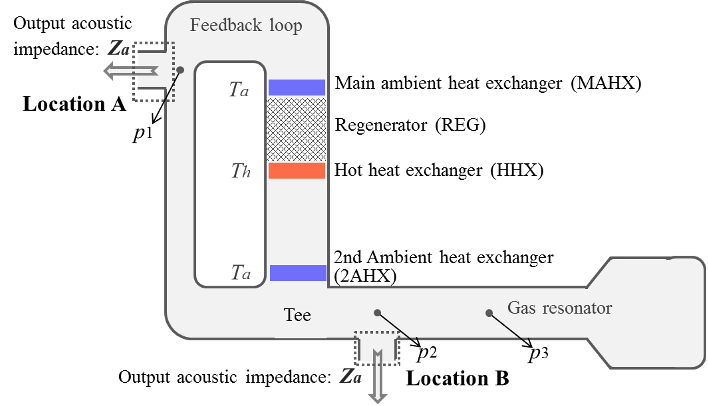Acoustic matching of a traveling-wave thermoacoustic electric generator
Reads0
Chats0
TLDR
In this paper, an effective approach for matching the acoustic impedances of the thermoacoustic engine and the linear alternators for maximizing the output electric power and thermal-to-electric efficiency was presented.About:
This article is published in Applied Thermal Engineering.The article was published on 2016-06-05 and is currently open access. It has received 36 citations till now. The article focuses on the topics: Thermoacoustics & Acoustic impedance.read more
Figures

Figure 2. Two output locations of traveling-wave thermoacoustic engines 
Table 1. Main geometric dimensions of traveling-wave thermoacoustic engine. 
Figure 8. Input acoustic power and output electric power vs. operating frequency. 
Figure 7. Equivalent displacements |x1| at (a) location A and (b) location B with respect to output acoustic impedance Za. 
Figure 13. Effect of load resistance on acoustoelectric efficiency of linear alternators. 
Table 2. Parameters of linear alternators.
Citations
More filters
Journal ArticleDOI
Review on the conversion of thermoacoustic power into electricity
TL;DR: A review of the four main methods to convert the (thermo)acoustic power into electricity is provided in this article, focusing on possible configurations, operating characteristics, output performance, and analytical and numerical methods to study the devices.
Journal ArticleDOI
Multi-physics coupling in thermoacoustic devices: A review
TL;DR: In this paper, a comprehensive review of the multi-physics coupling effects, namely, thermal-acoustic coupling, acoustic-mechanical coupling and mechanical-electric coupling, inside thermoacoustic devices including thermo-acoustically-driven refrigerators, etc.
Journal ArticleDOI
Thermoacoustic Stirling power generation from LNG cold energy and low-temperature waste heat
TL;DR: In this article, the authors applied the thermoacoustic Stirling electric generator to recover LNG cold energy and waste heat simultaneously, which can help to improve the energy efficiency of LNG power generation systems, meanwhile, abundant low-grade waste heat can also be exploited from the exhaust gas of gas turbines.
Journal ArticleDOI
Numerical analysis on a four-stage looped thermoacoustic Stirling power generator for low temperature waste heat
TL;DR: In this paper, a four-stage looped thermoacoustic Stirling power generator for generating electricity from low temperature waste heat at 300°C is systematically studied, and the effects of the coupling position for the linear alternators and the regenerator position on the acoustic characteristics and performances of the power generation system are numerically investigated.
Journal ArticleDOI
Numerical study on a heat-driven piston-coupled multi-stage thermoacoustic-Stirling cooler
Jing-Yuan Xu,Jingyuan Xu,Jingyuan Xu,Jianying Hu,Ercang Luo,Jiangfeng Hu,Limin Zhang,Simone Hochgreb +7 more
TL;DR: In this paper, a heat-driven multi-stage thermo-acoustic cooler is proposed to satisfy cooling requirements in the applications of natural gas liquefaction and high-temperature superconductivity.
References
More filters
Journal ArticleDOI
A novel method for improving the performance of thermoacoustic electric generator without resonator
Yufang Wang,Zhengyu Li,Qing Li +2 more
TL;DR: In this paper, a traveling-wave looped-tube thermoacoustic heat engine coupling with two linear alternators is proposed to improve the performance of the thermo-acoustic electric generator.
Journal ArticleDOI
Coupling between thermoacoustic resonance pipes and piezoelectric loudspeakers studied by equivalent circuit method
Li Fan,Shu-yi Zhang,Ben-ren Wang +2 more
TL;DR: In this article, an integrated equivalent circuit model of a thermoacoustic resonance pipe driven by a piezoelectric loudspeaker is presented to investigate the coupling conditions between the PLS and the HCRP.
Journal ArticleDOI
Output characteristics of Stirling thermoacoustic engine
TL;DR: In this article, the authors studied the acoustic power distribution in a Stirling TE with variable load and found that the thermal efficiency is independent of the output locations along the engine under the same acoustic power output.
Recent Stirling Conversion Technology Developments and Operational Measurements
TL;DR: The ASRG EU has accumulated over 4,000 hours of operation and has been used at NASA's Glenn Research Center (GRC) since 2008 as mentioned in this paper, with the exception of electrical heating in place of a radioisotope source.
Proceedings ArticleDOI
Recent Stirling Conversion Technology Developments and Operational Measurements at NASA Glenn Research Center
TL;DR: In support of the Advanced Stirling Radioisotope Generator (ASRG) project and other potential applications, NASA Glenn Research Center (GRC) has initiated convertor technology development efforts in the areas of acoustic emission, electromagnetic field mitigation, thermoacoustic Stirling conversion, and multiple-cylinder alpha arrangements of Stirling machines as discussed by the authors.